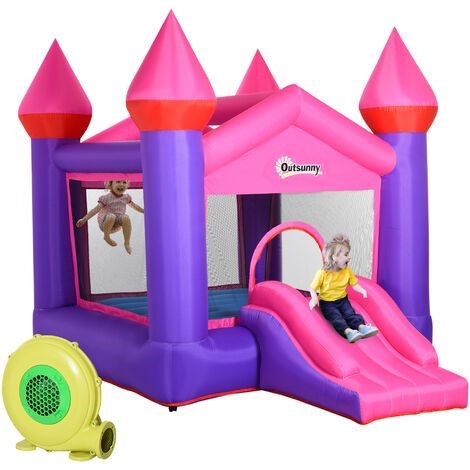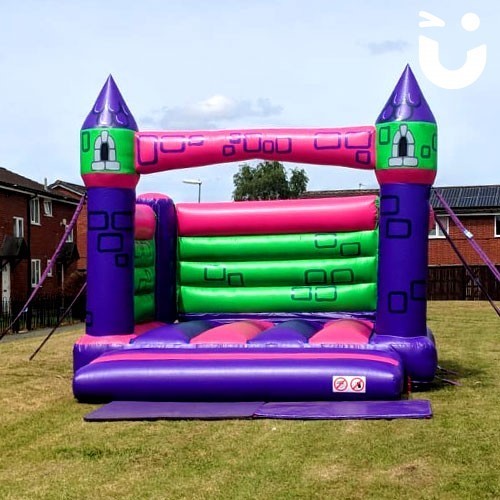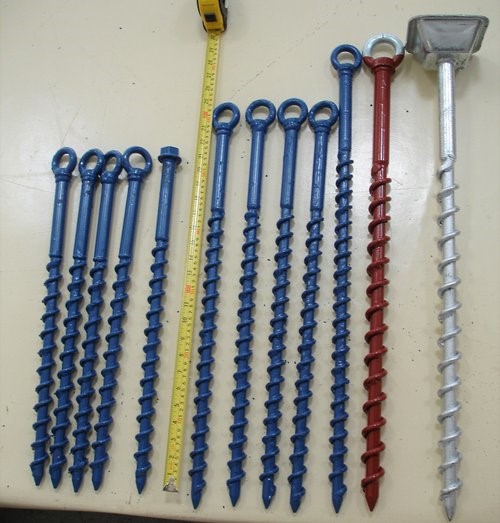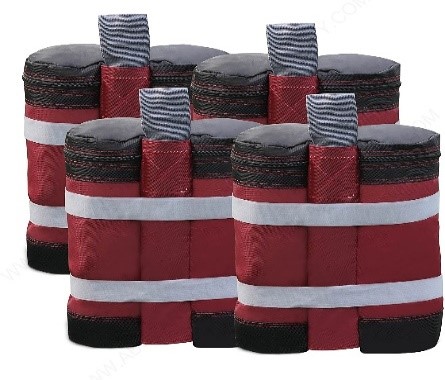This guidance provides advice to organisers of small events, where the use of inflatables such as bouncy castles are to be provided.
It is important to be aware that any inflatable used for commercial purposes in the UK should have been made to the British Standard BS EN14960:2013.
An inflatable device brought from a high street toy shop or online, is likely to be unsuitable for commercial use and is unlikely to meet the requirements of BS EN 14960:2013
The difference between a toy bouncy castle and a professional quality inflatable are obvious:


Commonly occurring hazards associated with the use of inflatables:
- instability and blowing away in windy conditions;
- Loss of pressure due to failure of the fabric zips and seams.
- Loss of power to the blower, or disconnection.
- Litter blocking the blower air intake or vents
- Falls from the structure;
- Windows tearing or detaching;
- Tripping (particularly over anchorages);
- User injury due to boisterous behaviour,
- Overcrowding or failing to separate larger users from smaller ones
- Contact with unguarded or unprotected parts of machinery such as blower units.
- Electrical hazards resulting in shock or burns.
- Inadequate means of escape in case of fire.
- Lifting injuries caused by manual handling.
- Users injuries caused by wearing inappropriate clothing and shoes, wearing glasses, having keys and other sharp objects in pockets
- Suffocation and entrapment.
Safe use and good practice when using inflatable devices:
Do
- Ensure that the inflatable is properly anchored to the ground, using every available anchor point, regardless of wind levels, to prevent instability and creep.
- Ensure that an adult supervisor is in attendance at all times, and that all operation instructions are followed.
- Ensure users are of a similar age, height and weight to avoid injuries.
- Ensure the equipment does not become overcrowded, and recommended numbers for the equipment are not exceeded.
- Ensure suitable and adequate soft gym mats are provided, especially when adjacent to hard surfaces.
- Ensure all users remove sharp objects such as glasses, belt buckles, keys, shoes etc.
- Only hire your inflatables from a PIPA Registered and reputable operator, and not the cheapest.
- Do not be tempted to buy a domestic inflatable device which is not intended for commercial use. They are often cheaply made and therefore more likely to fail and cause injury.
- Always check that the equipment has a current test certificate.
- Ensure the instructions provide by the hirer are followed.
- Ensure that the blower is at least 1.2 meters away from the inflatable to prevent potential injuries.
- Ensure spectators do not obstruct the entrance/exits and block supervisors view.
- Do not allow users onto the inflatable when being inflated or deflated.
Don’t
- Don’t allow users onto inflatables in high winds or wet weather
- Don’t allow users to climb on the walls of bouncy castles, which is a common cause of injury.
- Don’t deflate the inflatable whilst it is in use, as this can cause users to strike the ground.
- Don’t use the inflatable if you have doubts about its safety.
- Don’t allow objects or users to be thrown onto the inflatable.
- Don’t allow users who do not meet the minimum height requirements
- Don’t allow users to eat or drink or chew gum, when using the inflatable.
- Don’t allow any user to play on the step or front apron of the inflatable.
- Don’t continue to use the inflatable if you have any doubts about the safety or integrity of the inflatable or associated equipment, until it has been inspected by a competent person.
Annual inspection
The Provision of Work Equipment Regulations 1998 (PUWER) require inflatable devices to be inspected at least once in 12 months to ensure it is in a safe conditions and that any deterioration in the device is detected and remedial action taken in good time.
This inspection needs to be carried out by a competent person and should include the following:
- previous inspection reports and certificates where appropriate;
- provision of a blower unit as specified by the manufacturer, or one that at least provides sufficient pressure to allow the inflatable to be used safely, suitably guarded at the air inlet and outlet;
- condition of blower impeller and fan casing where practicable to inspect;
- condition of accessible blower electrical wiring;
- condition of all electrical installations;
- anchorage system for wear, rips or chafing;
- type and number etc of ground anchors or ballast for conformity with design specification;
- structure for wear or rips in the fabric;
- walls and towers (when fitted) are firm and upright;
- pressure is sufficient in the bouncing area and at the step/front apron to give a reliable and firm footing;
- internal ties for wear and tear, particularly at loose or exposed ends;
- bed seams, wall-to-bed seams and wall-to-tower connections;
- identification of the device; and
- if used on a fixed site, the location.
Inspection of some of these features may need to be done inside the device. The above list is not exhaustive, and the manufacturer may specify additional items.
Daily Checks
Checks should be carried out before the first use on any day, including;
- When the inflatable is being operated outside, use an anemometer to measure the wind speed at regular intervals. If one of these is not available, the inflatable should not be operated outside. These measurements should be recorded.
- Do not use smartphone weather applications to measure wind speed as they do not take localised wind conditions into account.
- the site remains suitable, with crowd control measures in place if appropriate;
- anchorages are intact, protected where necessary, and ropes not worn or chafed;
- anchor system secures the inflatable device to the ground;
- there are no significant holes or rips in the fabric or seams;
- the correct blower specified for the device is being used and the air pressure is sufficient to give a reliable and firm footing;
- there are no exposed electrical contacts, there is no wear on electric cables, and plugs, sockets and switches are not damaged;
- if an internal combustion engine is used, that the fuel cap is placed firmly on the fuel tank and any reserve fuel tank is suitable and remains in a safe position;
- bolts and screws of the blower are properly secured and that robust guards are secured over the air inlet and outlet;
- the blower/inflation tube connection is in good condition and is firmly fixed to the blower; and
- the blower is positioned correctly, adequately protected or guarded and is not causing a tripping hazard.
Securing the inflatable
It is essential for the safe operation of a device that the manufacturer’s instructions regarding the use of anchorage points should be followed. The device should be secured to the ground with ground stakes, where the ground is suitable. Some equally effective method can be used on hard standing, e.g. attaching the anchor ropes to fittings already in the ground, or to sandbags or other weights, if these are capable of taking the load. Inflatables can be tied to a vehicle or other movable machinery, providing the vehicle or machinery is immobilised and under the control of the operator.


Windy conditions & inclement weather
Inflatables should not be used when the wind or gusts are in excess of the maximum safe wind speed specified by the manufacturer. The industry recommends a maximum wind speed of Force 5 on the Beaufort scale of 30-38 kph (19-24 mph). Force 5 is a fresh breeze when small trees in leaf begin to sway. In comparison, a force 6 is a strong breeze when large branches are in motion, whistling can be heard in telephone lines, and umbrellas can only be handled with difficulty.
Other hazards
The controller or operator should ensure that the inflatable device is sited well away from possible hazards such as overhead power lines or other obstacles with hazardous projections (e.g. fences). If the ground surface is abrasive, oily or dirty, a ground sheet should be used to prevent wear and tear of the base material.
Supervision
The controller should determine the minimum number of attendants needed to operate the device safely and ensure that at least these numbers of attendants are on duty when the device is in operation. In deciding how many attendants are required, the controller needs to consider matters such as the number of people using the device, the age of the users and the type of environment in which the inflatable is being used. Attendants should be aged 16 or over and the operator should be 18 or over.
Crowd control
If the risk assessment carried out by the controller shows that control measures are required to handle large crowds in the immediate vicinity of the inflatable, then crowd control barriers should be provided by the controller. They should be at least 1 m high and be capable of withstanding people leaning on them or being pushed against them. Where the public does not have access to the sides or back of the inflatable or crowd pressures are not anticipated, then a lower standard is acceptable.
Training
The controller should ensure that all operators receive effective training in the working of the device including:
- the method of operating the device;
- safe methods of assembly/dismantling, where applicable; and
- how to make a daily check;
The controller should ensure that all operators and attendants receive effective training in the operation of the device including:
- safe entry/exit for users;
- safe anchoring of the inflatable;
- crowd control measures, and barriers;
- measures to be taken in the event of power failure; and
- procedures for reporting accidents, defects or breakdowns.
Questions to ask an operator when hiring a bouncy castle or other inflatable play equipment
- Are you conforming to the PIPA Scheme?
- Have you carried out the daily checks on the equipment?
- When was the equipment last fully inspected?
- Will I get full instructions on its SAFE operation?
- What is the inflatable’s PIPA tag?
- Can I see the current PIPA test certificate for this equipment?
- If I set it up with the blower unit at 1.2 metres distance will it still fit on my site?
- Is the equipment clearly marked as to its limitations of use? (max. user height etc.)
- Are you a member of a relevant association (AIMODS, TIPE or BIHA)? (Check this against the relevant web site listing (See Participating Organisations)
- Do you have Public Liability Insurance?
The PIPA Scheme
PIPA Inflatable Play Association is a play industry inspection scheme designed to provide a system whereby play equipment can conform to the testing and inspection requirements of the relevant health and safety law. All inflatable play equipment falls within the scope of the PIPA scheme should carry a PIPA tag and be listed in the PIPA database https://www.pipa.org.uk.
The PIPA scheme is supported by the whole industry and was developed in partnership with the Health and Safety Executive.
A PIPA tag means:
- The inflatable has been designed to recognise standard based on safety.
- Tested by nationally qualified inspectors and equipment has been approved for commercial use.
- The PIPA scheme delivers:
- Improved child safety
- Certified initial test.
- Certified annual testing
Tags
Following a design revision, there are now two types of tags:
Old: before Dec 2009, New: The new tag is flexible with two of the ‘jumping i’s in metallic foil.’
Getting help:
If you have any questions please feel free to contact us, or alternatively you may find the following websites and documents helpful:
Sources of further information:
PIPA Inflatable Play Inspection
PIPA Essential Reading – Frequently Asked Questions
Amusement Device Inspection Procedures Scheme (ADIPS)
HSE Information Sheet – Safe use and operation of play inflatables, including bouncy castles

